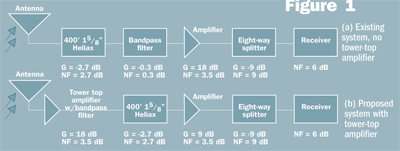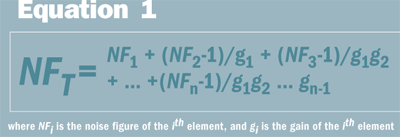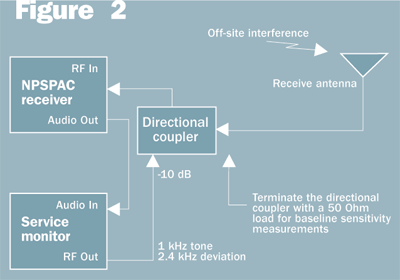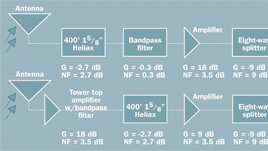Tower-top amplifiers and noise figure (Part 2 of 2)
Part 2 of 2
Last month in Tech Speak, we introduced the concept of noise figure and calculated the noise figure improvement created by a tower-top amplifier in a system limited by receiver thermal noise. This month, we examine the case where a tower-top amplifier must operate in the presence of external interference as well as thermal noise.
Let’s consider the same hypothetical example as last month: a five-channel 800 MHz trunked radio system operating in the NPSPAC band (821 MHz to 824 MHz, 866 MHz to 869 MHz). The receive antenna is located on a tower 350 feet above ground, and there is a 50-foot coaxial cable that runs from the tower to the repeater. The existing system does not employ a tower-top amplifier (TTA), and the system manager wants to know if a TTA will improve the talk-back range. Figure 1 shows the block diagrams for the existing and proposed systems.

Note that the gain in the receiver multicoupler amplifier is 18 dB in the original system and 9 dB with the TTA. This gain reduction is necessary to reduce the chance of receiver overload and receiver intermodulation. As we noted last month, the net gain with the TTA is still higher than the original system (15.3 dB versus 6.3 dB) and therefore the system with the TTA is more vulnerable to receiver overload and receiver intermodulation.
We also showed last month that by applying Equation 1 to the two configurations shown in Figure 1, we find that the composite noise figure without the TTA is 7.4 dB, and the composite noise figure with the TTA is 3.8 dB. In other words, the noise figure and hence receiver sensitivity are improved by a factor of 3.6 dB [7.4 dB – 3.8 dB] in the absence of interference.

Now let’s consider the effect of interference. Our objective is to measure or deduce the interference power at the repeater site, compute the C/(I+N) with and without the TTA, and thereby quantify the improvement offered by the amplifier.
Rather than measure the interference power directly, we choose to measure the effect of the interference on receiver sensitivity. We will measure three receivers and average the results. The figure-of-merit is 12 dB SINAD, and two measurements are taken for each receiver, one with the receiver terminated in a 50 Ohm load and one with the receiver connected to the receive antenna on the tower. The test configuration is shown in Figure 2, with the results listed in Table 1 (below).

Now let’s make the simplifying assumption that interference has the same effect on SINAD as thermal noise. Let N = thermal noise power and I = interference power. From Table 1, we found that the introduction of external interference decreased the C(I+N) by a factor of 4 (6 dB). Therefore, (I + N)/N = 4.0 and I = 3N. In other words, the interference power at the receiver front-end is a factor of 3 (4.8 dB) stronger than the thermal noise power in the receiver when no tower-top amplifier is used.
Now, if we add the TTA to this system, we know the C/N will be improved by 3.6 dB, but how much will the C/(I+N) be improved? Remember that the TTA amplifies the carrier and the interference equally, so the C/I is constant through the system. Also, recall that the composite noise figure is 3.8 dB, and the noise figure of the receiver is 6 dB.
Thus, there is a net reduction in thermal noise (relative to the carrier) of 6.0 – 3.8 = 2.2 dB. In other words, the thermal noise power in the receiver, relative to the carrier, is 60% of the original. (The actual noise power is higher than the original noise power because of amplification, but we are only concerned about the noise power relative to the carrier.) We want the sum of the interference power and the noise power in the receiver. We can calculate it in terms of the original thermal noise power, N, as
I + N = 3N + 0.60N = 3.6N
versus I + N = 4N for the original system. In decibels, the improvement in sensitivity is 10log10(4.0/3.6) = 0.46 dB. Thus, the performance benefit of the TTA is reduced from a theoretical best case of 3.6 dB to only 0.46 dB because interference is present.
The editor limits this column to 1200 words, so I will leave it as a homework assignment to show that for an interference desense of a and a TTA noise figure improvement relative to the receiver of b, the C/(I+N) improvement is simply a/(a+ 1/b – 1).
In general, compute the potential TTA improvement as follows:
-
Step 1: Measure the desense caused by external interference, a.
-
Step 2: Compute the composite noise figure of the prospective TTA system.
-
Step 3: Compute the ratio of the receiver NF to the composite TTA NF, b.
-
Step 4: Improvement = IMP = a/(a + 1/b – 1), with a > 1 and b > 1.
-
Step 5: Convert to dB; IMP = 10log10(IMP) dB.
Table 2 (below) lists the TTA improvement factors for some typical values of interference desense, a, and noise figure improvement relative to the receiver, b.
It should be clear from Table 2 that a TTA is not always the magic bullet. If interference is strong relative to the thermal noise floor, the TTA will offer little improvement in receiver sensitivity.
Before giving up on the tower-top amplifier, the system manager should determine whether the interference originates offsite or locally. If the interference is local (co-site interference), it should be isolated and corrected so the TTA can do its intended job. If the interference originates offsite, there may be no recourse.
Jay Jacobsmeyer is president of Pericle Communications Co., a consulting engineering firm located in Colorado Springs, Colo. He holds a bachelor’s and master’s degree in electrical engineering from Virginia Tech and Cornell University, respectively, and has more than 20 years experience as a radio frequency engineer.
| Channel | Frequency (MHz) | 12 dB SINAD Terminated (dBm) | 12 dB SINAD Over-the-Air (dBm) | Desense (dB) |
|---|---|---|---|---|
| 1 | 821.6375 | -121.3 | -115.7 | 5.6 |
| 2 | 822.1750 | -121.1 | -115.2 | 5.9 |
| 3 | 822.7250 | -122.4 | -116.0 | 6.4 |
| Noise Figure Improvement Relative to Receiver Noise Figure = b (dB) | ||||||
|---|---|---|---|---|---|---|
| Desense = a (dB) | 1 | 2 | 3 | 4 | 5 | 6 |
| 0 | 1.0 | 2.0 | 3.0 | 4.0 | 5.0 | 6.0 |
| 1 | 0.8 | 1.5 | 2.2 | 2.8 | 3.4 | 3.9 |
| 2 | 0.6 | 1.2 | 1.6 | 2.1 | 2.5 | 2.8 |
| 3 | 0.5 | 0.9 | 1.2 | 1.6 | 1.8 | 2.0 |
| 4 | 0.4 | 0.7 | 1.0 | 1.2 | 1.4 | 1.5 |
| 5 | 0.3 | 0.5 | 0.7 | 0.9 | 1.1 | 1.2 |
| 6 | 0.2 | 0.4 | 0.6 | 0.7 | 0.8 | 0.9 |
| 7 | 0.2 | 0.3 | 0.5 | 0.6 | 0.6 | 0.7 |
| 8 | 0.1 | 0.3 | 0.4 | 0.4 | 0.5 | 0.5 |
| 9 | 0.1 | 0.2 | 0.3 | 0.3 | 0.4 | 0.4 |
| 10 | 0.1 | 0.2 | 0.2 | 0.3 | 0.3 | 0.3 |

















